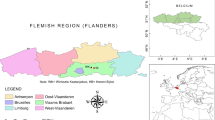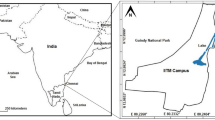Abstract
Over-exploitation of groundwater in the regions favorable for human settlements around the world has raised uncertainties on the sustainability of this precious resource in the future. However, the stress on the fresh groundwater zones can be reduced substantially by managing inland brackish/saline aquifers. Freshwater when available in excess can be stored judiciously in such aquifers for later on use; though a certain quantity of fresh water is lost during its storage and recovery depending upon the in situ groundwater gradient and buoyancy effect (caused due to density difference in the injected and ambient waters). Hence, increasing the efficiency of freshwater recovery was our prime concern, and for which there was a need to know the interface boundaries of freshwater stored in the ambient water. For the purpose, a new method has been developed and proposed in this paper that is based on the hydraulics of an injection well and the breakthrough curve of the injected tracer through the storage medium (i.e. aquifer). The close agreement between the outcome of the proposed model and method with the field observations has validated the acceptance of this innovative concept. The model results show that the shape acquired by the injected freshwater in the brackish/saline aquifer depends upon the screened location of the well about its centerline. Additionally, the storage of freshwater in the upper portion of the aquifer is the most efficient way to minimize its contact with the ambient water and subsequently its loss due to the development of the dispersion zone.






Similar content being viewed by others
Availability of Data and Material
We performed a field experiment to procure data and the complete infrastructure belongs to the project.
Abbreviations
- a L :
-
Longitudinal dispersivity [L]
- ‘b’:
-
Aquifer thickness [L]
- C 0 :
-
Original concentration of tracer in injected water
- C0(di):
-
The chemical concentration of groundwater at depth di
- Ct(di):
-
The chemical concentration of groundwater at depth di after injecting freshwater for time ‘t’
- CI(Su ↔ Sl):
-
The chemical concentration of the injected water through the well screen (Su ↔ Sl)
- C(r, t):
-
Tracer concentration at any radial distance ‘r’ after an injection period ‘t’
- ‘c’:
-
Hydraulic resistance of the leaky confining layer of the aquifer [T]
- D AS :
-
The vertical distance between the perpendicular bisector of the well screen axis and the centerline of the aquifer [L]
- EC :
-
Electrical conductivity (dS/m)
- K :
-
Hydraulic conductivity of the aquifer [L/T]
- K0(!), K1(!):
-
Modified Bessel functions of the second kind of order zero and one, respectively
- ‘k’:
-
Permeability of the porous medium [L2]
- L; Li :
-
Characteristic pore (or porous medium) length; of ith flow segment [L]
- n p :
-
Aquifer porosity (%)
- \( {p}_v^n \) :
-
Number of pore volumes
- Q i :
-
Injection rate [L3/T]
- R :
-
The distance of the observation well from injection well [L]
- ‘r’:
-
Radial coordinate [L]
- S :
-
Storage coefficient of the aquifer (dimensionless)
- SAR :
-
Sodium adsorption ratio (meq./l)½
- d i :
-
Groundwater sampling depth at ith location [L]
- S i :
-
Porous medium’s ith flow segment
- S l :
-
Depth of the lower level of the well screen from the top of the aquifer [L]
- S u :
-
Depth of the top of the well screen from the top of the aquifer [L]
- ‘t’:
-
Time [T]
- ‘vd’:
-
Darcy velocity [L/T]
- V p :
-
Pore water velocity [L/T]
- X p :
-
Characteristic pore cross-section [L2]
- ‘z’:
-
Vertical coordinate [L]
- ε(R, di)t :
-
Relative concentration distribution of injected fluid into ambient fluid monitored at a location (R, di)after an injection period ‘t’
References
Bakker M (2010) Radial Dupuit interface flow to assess the aquifer storage and recovery potential of saltwater aquifers. Hydrogeol J 18(1):107–115
Bear J, Jacobs M (1965) On the movement of water bodies injected into aquifers. J Hydrol 3(1):37–57
Brown CJ, Ward J, Mirecki J (2016) A revised brackish water aquifer storage and recovery (ASR) site selection index for water resources management. Water Resour Manag 30(7):2465–2481
Cederstrom DJ (1947) Artificial recharge of a brackish water well. US Geological Survey, 48–55
Custodio E (2002) Aquifer overexploitation: what does it mean? Hydrogeol J 10(2):254–277
Esmail OJ, Kimbler OK (1967) Investigation of the technical feasibility of storing fresh water in saline aquifers. Water Resour Res 3(3):683–695
Foster SSD, Tyson G, Voss C, MacDonald AM, Aureli A, Aggarwal P (2016) Global change and groundwater. International Association of Hydrogeologists, Strategic Overview Series on Global Change & Groundwater, 6pp
Harpaz YOAV, Bear J (1964) Investigations on mixing of waters in underground storage operations. XIII Assembly of the IUGG, Berkeley, California, IASH, IAHS-Red Books, Publ, 64: 132–153
Kimrey JO (1989) Artificial recharge of groundwater and its role in water management. Desalination 72(1–2):135–147
Lowry CS, Anderson MP (2006) An assessment of aquifer storage recovery using ground water flow models. Groundw 44(5):661–667
Lu C, Luo J (2010) Dynamics of freshwater-seawater mixing zone development in dual-domain formations. Water Resour Res 46(11):W11601
Merritt ML (1986) Recovering fresh water stored in saline limestone aquifers. Groundw 24(4):516–529
Pyne RDG (2002) Aquifer storage recovery wells: the path ahead. Fla Water Resour J:19–27
Thompson AR, Stotler RL, Macpherson GL, Liu G (2015) Laboratory study of low-flow rates on clogging processes for application to small-diameter injection wells. Water Resour Manag 29(14):5171–5184
Vacher HL, Hutchings WC, Budd DA (2006) Metaphors and models: the ASR bubble in the Floridan aquifer. Groundw 44(2):149–154
Van der Gun J (2016) Groundwater and global change: trends, opportunities and challenges, United Nation’s World Water Assessment Program, 44p
Vashisht AK, Shakya SK (2013a) Hydraulics of a drainage well fully penetrating a leaky aquifer through multisection screen. J Hydraul Eng ASCE 139(12):1258–1264
Vashisht AK, Shakya SK (2013b) Hydraulics of a multi-section screened well while draining ponded land in a leaky aquifer. ISH J Hydraul Eng 19(3):164–178
Vashisht AK, Shakya SK (2016) Flow through multiple well points system, Groundwater - Contaminant and Resource Management, Muhammad Salik Javaid, IntechOpen. https://doi.org/10.5772/63347.45-68
Wada Y, Van Beek LP, Van Kempen CM, Reckman JW, Vasak S, Bierkens MF (2010) Global depletion of groundwater resources. Geophys Res Lett 37(20):L20402
Ward JD, Simmons CT, Dillon PJ (2007) A theoretical analysis of mixed convection in aquifer storage and recovery: how important are density effects? J Hydrol 343(3–4):169–186
Zuurbier KG, Bakker M, Zaadnoordijk WJ, Stuyfzand PJ (2013) Identification of potential sites for aquifer storage and recovery (ASR) in coastal areas using ASR performance estimation methods. Hydrogeol J 21(6):1373–1383
Funding
Project entitled “Agricultural drainage under actual farming conditions on watershed basis”, Punjab Agricultural University, Ludhiana, Punjab, India.
Author information
Authors and Affiliations
Contributions
All authors contributed equally.
Corresponding author
Ethics declarations
Conflict of Interest
Not Applicable
Code Availability
Not Applicable
Additional information
Publisher’s Note
Springer Nature remains neutral with regard to jurisdictional claims in published maps and institutional affiliations.
Rights and permissions
About this article
Cite this article
Vashisht, A.K., Shakya, S.K. An Innovative Approach to Assessing the Distribution of Stored Freshwater while Injecting it through a Well Partially Screening the Brackish Aquifer. Water Resour Manage 34, 4687–4701 (2020). https://doi.org/10.1007/s11269-020-02682-6
Received:
Accepted:
Published:
Issue Date:
DOI: https://doi.org/10.1007/s11269-020-02682-6




